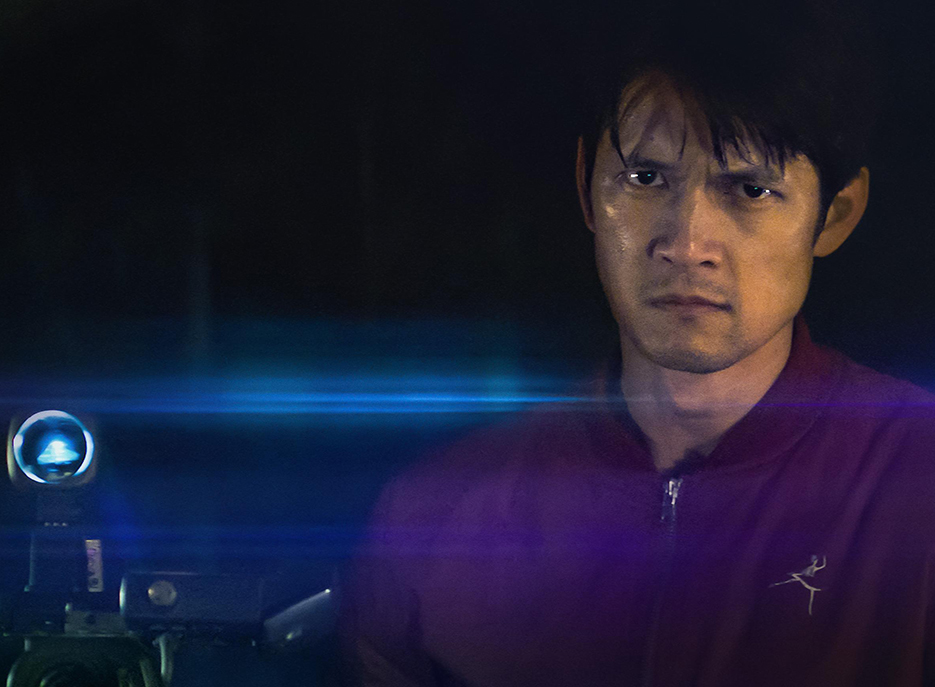In “Broadcast Signal Intrusion,” which played in the ‘Midnighters’ section at this year’s SXSW festival, Harry Shum Jr. plays James, a video archivist who tumbles down a rabbit hole of obsession. It starts when he finds a video, referred to as the Sal-E Sparx Incident, that depicts something truly bizarre and surreal. This is the rare phenomenon called a broadcast signal intrusion where someone hacks into a TV station’s satellite and broadcasts their own video.
The videos depicted in this film are amongst the creepiest aspects in director Jacob Gentry’s overall vision. (Mind you, these specific sequences were directed by Daniel Martin.) They’re truly unsettling because, while there’s nothing specifically terrifying about them, they’re unsettling because you can’t exactly pinpoint what’s happening.
The film itself is set in Chicago 1999 and has an appreciation for this era, shown through James’ gadgets. Gentry’s visual aesthetic paired with Scott Thiele’s cinematography captures the look and feel of conspiracy theory movies and detective films. It also all syncs well with with the writing by Phil Drinkwater and Tim Woodall.
James feels like a layered character as he tries to get over the disappearance of his wife, Hannah, from years ago. How that aspect of himself ties into his tireless search into the Sal-E Sparx Incident intrigues. A lot of his development comes from this obsession.
It’s not crystal clear why he starts the journey, but it is clear why he stays on it. He simply pulls at a thread and can’t stop pulling at it. I believe the explanation for his obsession boils down to seeing something unexplained like this that you either ignore it or dive headfirst into it. As well, these tapes seem to have a magnetic intrigue about them.

Assisting us through this journey is the great score by Ben Lovett. It’s jazzy and sounds reminiscent of detective films (I thought of the recent “Motherless Brooklyn”) but also conspiracy movies of the era. It’s exciting and unsettling and one of the biggest draws that sucked me into this world, as James investigates the broadcast signal intrusion that was never solved. It’s also neat the film never feels like it’s pigeonholed to one genre as a hybrid of lite sci-fi, horror, and especially mystery and thriller. This adds to the unpredictability to this as I never once knew where it would end.
While the journey discovering this information compels, I did take issue with the ending as we are left with more questions than answers. It’s surely thought-provoking and not as disappointing as “Under the Silver Lake” (a surreal story that gave us answers I did not like). “Broadcast Signal Intrusion” appears to implement the sentiment that since James is so obsessed, he was never going to be satisfied with the answers, regardless of what happened. It’s a middling end after all the build-up, which has a lot of interesting sequences and research into this phenomenon.
That build-up includes James navigating creepy online chatrooms and following information trails. It’s interesting when he crosses paths with people who have gone down this research road before but haven’t had great results. Also assisting in his obsessive quest is a woman he befriends, Alice (Kelley Mack), who is a welcome change-of-pace as she offers a second set of eyes on these videos. Since Harry has looked at these videos so obsessively, he’s bound to miss some things.
They have a strong dramatic chemistry and banter as she offers her expertise. As well, Harry Shum Jr. is solid on his own but together they are more compelling to watch. A scene they share with a character played by Chris Sullivan is one of the best sequences in the film in terms of tension and storytelling, which is where “Broadcast Signal Intrusion” is at its strongest.


